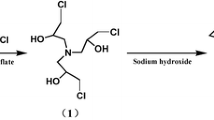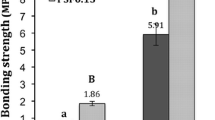Abstract
This study reports on the preparation and application of bio-based adhesive derived from renewable defatted soy flour (DSF) and epichlorohydrin (ECH), aiming at substituting formaldehyde-based adhesives in the wood industry. DSF was treated with Viscozyme® L to hydrolyze plant cell wall carbohydrates and then adjusted to an extremely low pH with hydrochloric acid containing ferric chloride to unfold the tertiary and/or quaternary structure of soy protein and expose its functional groups. The treated DSF was then glycidized with ECH to obtain the bio-based adhesive. The resulting adhesive contained epoxy groups, which were evidenced by Fourier transform infrared spectroscopy, X-ray photoelectron spectroscopy, and 1H nuclear magnetic resonance. After curing, the epoxy groups contributed to good thermal stability and gluability of the adhesive. The grafting ratio of ECH decreased by 37.8% as the mass fraction added was increased from 5 to 25%, whereas the viscosity increased sharply by 2889.5% and the solid content increased slowly by 10.5%. Wet shear strength of Pinus massoniana plywood bonded with the bio-based adhesive with an ECH mass fraction of > 10% of the DSF mass was higher than 0.93 MPa, which met the requirements of the Chinese National Standard for plywood for interior/exterior applications. These results support the use of soy flour-based adhesives for plywood and provide data for evaluating their use as sustainable materials for other applications.






Similar content being viewed by others
References
Almena A, Martín M (2016) Technoeconomic analysis of the production of epichlorohydrin from glycerol. Ind Eng Chem Res 55:3226–3238
Amaral-Labat G, Pizzi A, Goncalves A, Celzard A, Rigolet S, Rocha G (2008) Environment-friendly soy flour-based resins without formaldehyde. J Appl Polym Sci 108:624–632
Auvergne R, Caillol S, David G, Boutevin B, Pascault J-P (2013) Biobased thermosetting epoxy: present and future. Chem Rev 114:1082–1115
Bergaoui M, Aguir C, Khalfaoui M, Enciso E, Duclaux L, Reinert L, Fierro JLG (2017) New insights in the adsorption of Bovine Serum Albumin onto carbon nanoparticles derived from organic resin: experimental and theoretical studies. Microporous Mesoporous Mater 241:418–428
Chen N, Lin Q, Rao J, Zeng Q (2013) Water resistances and bonding strengths of soy-based adhesives containing different carbohydrates. Ind Crop Prod 50:44–49
Chen N, Zeng Q, Rao J, Lin Q (2014) Effect of preparation conditions on bonding strength of soy-based adhesives via viscozyme L action on soy flour slurry. BioResources 9:7444–7453
Chen N, Huang J, Li K (2019) Investigation of a new formaldehyde-free adhesive consisting of soybean flour and Kymene® 736 for interior plywood. Holzforschung 73:409–414
Cheng E, Sun X, Karr GS (2004) Adhesive properties of modified soybean flour in wheat straw particleboard. Compos A 35:297–302
Chu JH, Kwak J, Kim S-D et al (2014) Monolithic graphene oxide sheets with controllable composition. Nat Commun 5:3383
Enterria M, Martin-Jimeno FJ, Suarez-Garcia F et al (2016) Effect of nanostructure on the supercapacitor performance of activated carbon xerogels obtained from hydrothermally carbonized glucose-graphene oxide hybrids. Carbon 105:474–483
Fache M, Montérémal C, Boutevin B, Caillol S (2015) Amine hardeners and epoxy cross-linker from aromatic renewable resources. Eur Polym J 73:344–362
Forrest T, Rabine JP, Rouillard M (2011) Organic spectroscopy workbook. Wiley, New York
Fourcade D, Ritter BS, Walter P, Schönfeld R, Mülhaupt R (2013) Renewable resource-based epoxy resins derived from multifunctional poly (4-hydroxybenzoates). Green Chem 15:910–918
Friedman M (2003) Chemistry, biochemistry, and safety of acrylamide: a review. J Agric Food Chem 51:4504–4526
Frihart CR, Satori H (2013) Soy flour dispersibility and performance as wood adhesive. J Adhes Sci Technol 27:2043–2052
Gadwal I, Khan A (2013) Protecting-group-free synthesis of chain-end multifunctional polymers by combining ATRP with thiol-epoxy ‘click’ chemistry. Polym Chem 4:2440–2444
Gardner SD, Singamsetty CS, Booth GL, He G-R, Pittman CU (1995) Surface characterization of carbon fibers using angle-resolved XPS and ISS. Carbon 33:587–595
Ghahri S, Pizzi A (2018) Improving soy-based adhesives for wood particleboard by tannins addition. Wood Sci Technol 52:261–279
Gu J (2015) Present situation and development trend of wood adhesives in China. Adhesion 36:28–31
Gu K, Li K (2011) Preparation and evaluation of particleboard with a soy flour-polyethylenimine-maleic anhydride adhesive. J Am Oil Chem Soc 88:673–679
Kim DH, Na SK, Park JS, Yoon KJ, Ihm DW (2002) Studies on the preparation of hydrolyzed starch-g-PAN (HSPAN)/PVA blend films: effect of the reaction with epichlorohydrin. Eur Polym J 38:1199–1204
Koronis G, Silva A, Fontul M (2013) Green composites: a review of adequate materials for automotive applications. Compos Part B 44:120–127
Li H, Kang H, Zhang W, Zhang S, Li J (2016) Physicochemical properties of modified soybean-flour adhesives enhanced by carboxylated styrene-butadiene rubber latex. Int J Adhes Adhes 66:59–64
Lu Q, Wu C, Liu D et al (2017) A facile and simple method for synthesis of graphene oxide quantum dots from black carbon. Green Chem 19:900–904
Luo J, Li C, Li X, Luo J, Gao Q, Li J (2015) A new soybean meal-based bioadhesive enhanced with 5, 5-dimethyl hydantoin polyepoxide for the improved water resistance of plywood. RSC Adv 5:62957–62965
Luo J, Luo J, Li X, Li K, Gao Q, Li J (2016) Toughening improvement to a soybean meal-based bioadhesive using an interpenetrating acrylic emulsion network. J Mater Sci 51:9330–9341
McMurry J (2011) Organic chemistry. Brooks/Cole, Monterey
Meier MA, Metzger JO, Schubert US (2007) Plant oil renewable resources as green alternatives in polymer science. Chem Soc Rev 36:1788–1802
Morin-Crini N, Crini G (2013) Environmental applications of water-insoluble β-cyclodextrin–epichlorohydrin polymers. Prog Polym Sci 38:344–368
Mottram DS, Wedzicha BL, Dodson AT (2002) Food chemistry: acrylamide is formed in the Maillard reaction. Nature 419:448–449
NgaiáSum Y (2013) Synthesis of cyclic carbonates with carbon dioxide and cesium carbonate. Green Chem 15:2086–2090
Nielsen GD, Larsen ST, Wolkoff P (2017) Re-evaluation of the WHO (2010) formaldehyde indoor air quality guideline for cancer risk assessment. Arch Toxicol 91:35–61
Ning YC, Ernst RR (2005) Structural identification of organic compounds with spectroscopic techniques. Wiley, New York
Ning YC, Ernst RR (2011) Interpretation of organic spectra. Wiley, New York
Othmer K (1993) Encyclopedia of chemical technology, chlorocarbons and chlorohydrocarbons-CSUB 2/SUB to combustion technology. Wiley, New York
Peng L, Xu Z, Liu Z et al (2015) An iron-based green approach to 1-h production of single-layer graphene oxide. Nat Commun 6:5716
Quéré D (2002) Surface chemistry: Fakir droplets. Nat Mater 1:14–15
Santacesaria E, Tesser R, Di Serio M, Casale L, Verde D (2009) New process for producing epichlorohydrin via glycerol chlorination. Ind Eng Chem Res 49:964–970
Thakur VK, Kessler MR (2014) Synthesis and characterization of AN-g-SOY for sustainable polymer composites. ACS Sustain Chem Eng 2:2454–2460
Vázquez G, González-Álvarez J, López-Suevos F, Antorrena G (2003) Effect of veneer side wettability on bonding quality of Eucalyptus globulus plywoods prepared using a tannin–phenol–formaldehyde adhesive. Bioresour Technol 87:349–353
Wu S (1987) Chain entanglement and melt viscosity of compatible polymer blends: poly (methyl methacrylate) and poly (styrene-acrylonitrile). Polymer 28:1144–1148
Xu Y, Xu Y, Zhu W, Zhang W, Gao Q, Li J (2018) Improve the performance of soy protein-based adhesives by a polyurethane elastomer. Polymers 10:1016
Zhang Y, Zhang M, Chen M, Luo J, Li X, Gao Q, Li J (2018) Preparation and characterization of a soy protein-based high-performance adhesive with a hyperbranched cross-linked structure. Chem Eng J 354:1032–1041
Zheng P, Chen N, Mahfuzul Islam SM et al (2019) Development of self-crosslinked soy adhesive by enzyme complex from Aspergillus niger for production of all-biomass composite materials. ACS Sustain Chem Eng 7:3909–3916
Zhu D, Damodaran S (2014) Chemical phosphorylation improves the moisture resistance of soy flour-based wood adhesive. J Appl Polym Sci 131:40451
Acknowledgements
The authors thank the National Natural Science Foundation of China (Grant No. 31500477) and the Natural Science Foundation of Fujian Province (Grant No. 2019J01389) for providing financial support for this research. We thank of the department of wood science and engineering at Oregon State University for the experimental support.
Author information
Authors and Affiliations
Corresponding author
Ethics declarations
Conflict of interest statement
On behalf of all authors, the corresponding author states that there is no conflict of interest.
Additional information
Publisher's Note
Springer Nature remains neutral with regard to jurisdictional claims in published maps and institutional affiliations.
Rights and permissions
About this article
Cite this article
Chen, N., Lin, Q., Zheng, P. et al. A sustainable bio-based adhesive derived from defatted soy flour and epichlorohydrin. Wood Sci Technol 53, 801–817 (2019). https://doi.org/10.1007/s00226-019-01102-2
Received:
Published:
Issue Date:
DOI: https://doi.org/10.1007/s00226-019-01102-2




